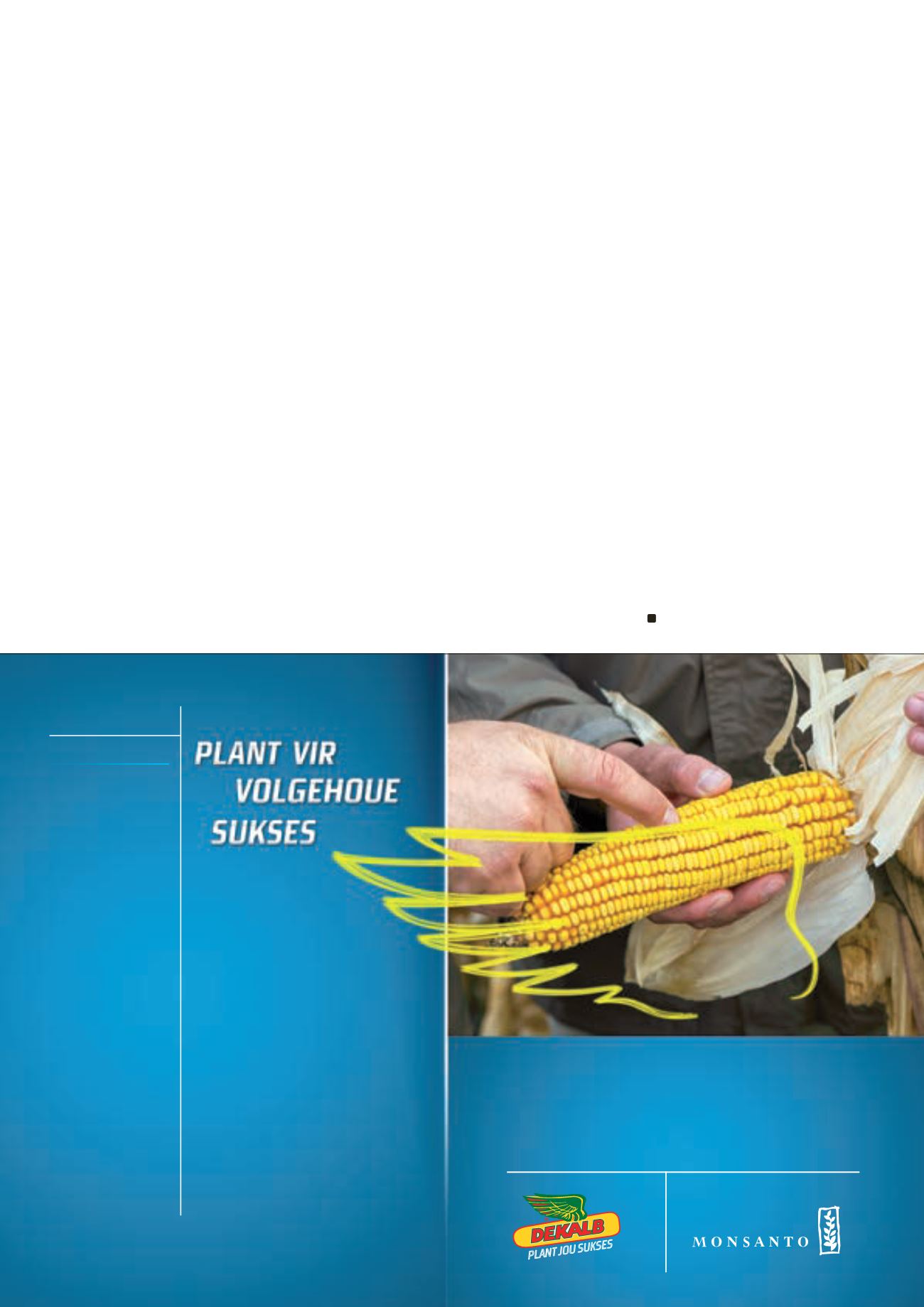

Met
DEKALB
®-saad as deel van
jou boerdery,
sorg jy vandag
reeds vir die dag vanmôre,
omdat jy weet, met
DEKALB
®
plant jy sukses. Ons tegnologie
en navorsing gerugsteun deur
spanwerk en professionele
advies dra by tot jou volgehoue
sukses, nie net vandag nie,
maar ook in die toekoms.
Geelmielies
DKC61-94BR
DKC80-40BR GEN
DKC80-12B GEN
DKC80-30R
DKC62-80BR GEN
DKC64-78BR GEN
DKC73-76R
DKC62-84R
DKC73-74BR GEN
DKC73-70B GEN
DKC73-72
DKC66-32B
DKC66-36R
DKC80-10
DKC61-90
Kultivars
PLANT JOU SUKSES
®
Monsanto tel: 011 790-8200 |
www.monsanto.co.zaKontak gerus ons kliëntediens by: 011 790-8200
of
customercare.sa@monsanto.comDEKALB
®
en Monsanto is geregistreerde handelsname van Monsanto Technology LLC.
Monsanto Suid-Afrika (Edms) Bpk, Posbus 69933, Bryanston, 2021.
uppemarketingA11827/SAG
glomalin content in conventional-till (maxi-
mum soil disturbance) were lower than in
the other tillage treatments tested.
Except for wheat monoculture, this reduc-
tion in soil quality, however, did not influ-
ence wheat grain yield. This proves that
the potential negative effect of continuous
soil disturbance may take years to cause
reductions in wheat yields. During the 2014
season, canola reacted positively on soil
disturbance resulting in increased yields as
the degree of soil disturbance increased.
Mr Abie Vorster (MSc Agric student), work-
ing on the long-term tillage/cropping sys-
tem trial at the Tygerhoek Research Farm,
reported that after seven years of applying
abovementioned treatment combinations,
no-till tended to result in better soil physi-
cal properties except for aggregate stability
that showed no response. These differenc-
es were however not significant.
Four posters related to the long-term till-
age/cropping system trial at Langgewens
were presented. Two posters by Dr La-
buschagne and Mr Johan Habig (ARC: PPRI)
showed no definite trend in the effect of
crop rotation on enzyme activity. Less soil
disturbance tended to increase enzyme
activity. Soil microbial diversity showed
higher sensitivity to cropping sequences,
than to tillage treatments.
Preliminary results showed that the com-
position of soil microbial diversity was the
lowest in wheat monoculture and the high-
est in a wheat/medic system. Low microbial
diversity in the wheat monoculture plots
could be the result of specialised microbial
populations present, with the ability to uti-
lise wheat root exudates more effectively.
Mr Heinrich van Zyl found that in the ab-
sence of tillage (zero- and no-till) at Lang-
gewens, less mobile elements (organic
C and P) tended to accumulate in the top
0 cm - 5 cm, a result not found for more mo-
bile elements like S.
Vorster could not find any significant dif-
ferences in soil water content, cumulative
evapotranspiration (water usage by system),
and grain yield and water use efficiency be-
tween tillage and crop rotation treatments
at Tygerhoek, however no-till tended to
perform better than the other treatments in-
cluded in the study.
Investigating the effect of a strategic once-
off tillage on soil quality was covered by
three posters. Preliminary results from
Tygerhoek by Mr Jacques Smith showed
that once-off tillage in a permanent pasture/
cash crop system (after lucerne) had no ma-
jor impact on soil quality in the short term.
Stratification of SOC after a long-term lu-
cerne crop could therefore be reduced ef-
fectively by means of once-off deep tine
or mouldboard plough without increased
losses of the active C content, an important
soil quality parameter.
Ms Izane Leygonie and Mr Johan van Zyl
(MSc Agric students) showed that after
applying a once-off tillage treatment (deep
tine or plough) at Langgewens, soil water
content was influenced by tillage, current
crop as well as the time when the soil wa-
ter content was recorded. Biomass produc-
tion of wheat and canola and chlorophyll
content of leaves were not influenced by the
tillage treatments tested. This is only pre-
liminary results; final recommendations will
be made upon completion of these studies.
The posters and papers delivered at the
Combined Congress were made possible
by the partial financial support of the long-
term research trials from the Winter Cereal
Trust.

















